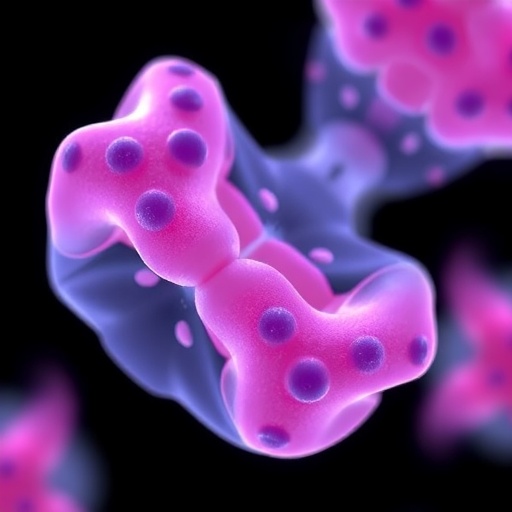In a groundbreaking development at the University of California, Santa Barbara (UCSB), researchers have successfully engineered an innovative algae-based gel capable of mimicking natural biological environments, specifically targeting the growth and study of mammary epithelial cells. This advancement is particularly noteworthy as it arose from the challenges posed by the COVID-19 pandemic, which disrupted the availability of commercially produced gels necessary for scientific research. Jane Baude, a Ph.D. candidate under the guidance of Professor Ryan Stowers, embarked on this ambitious project aimed at creating a novel gel from scratch rather than relying on traditional options which often come with limitations.
The algae-based gel serves as a synthetic substitute for the basement membrane that surrounds epithelial cells in vivo. This membrane is crucial as it provides both structural integrity and key biochemical signaling for the cells it envelops. Understanding how cells interact with their physical environment is essential in unraveling the complexities of tissue development and cancer progression. Current research indicates that the properties of the environment surrounding cells, such as stiffness and biochemical signals, play pivotal roles in determining cell behavior, which may lead to insights into cancer biology and potential therapeutic avenues.
Traditional gels used in cancer research are often derived from the basement membranes found in mouse tumors, constraining researchers to methods that may not accurately replicate human biology. Baude’s algae-based gel offers a customizable and ethical alternative that allows scientists to modify its composition to explore various environments that cells can inhabit. By changing parameters such as stiffness, crosslinking density, and biochemical signals, researchers can create conditions that replicate the behavior of both normal and malignant cells. This specificity enhances the understanding of how the microenvironment influences cell fate and function, providing a valuable platform for cancer research.
The significance of studying how mechanical properties influence cellular behavior cannot be overstated. Professor Stowers highlighted that cells are quite mechanosensitive, meaning they can sense changes in their environment, such as the difference between soft and hard matrices. This mechanosensitivity is a double-edged sword; it can dictate whether a cell behaves normally or transitions towards malignancy. The researchers’ work illustrates that benign tissues, such as the mammary gland, have distinctly softer bio-mechanical properties compared to malignant tumors, which tend to increase in stiffness as they progress. This correlation underscores the potential of using the new gel to determine how varying mechanical properties could guide the development of cancer.
To achieve their goal, Baude meticulously experimented with combinations of short peptide sequences within the algae-based gel to replicate the multi-dimensional characteristics of a commercially available gel known as Matrigel. This involved testing different crosslinking strategies and polymer chain lengths to discern the optimal composition that would not only support cell growth but also provide insights into the underlying mechanisms governing cellular behavior. Remarkably, their engineered gel has provided a venue for cells to create their own basement membranes in optimal conditions. However, misguiding the biochemical cues leads cells to produce inappropriate proteins, showcasing the delicate balance within epithelial development.
Incorporating engineering principles into the realm of developmental biology, Baude and Stowers have opened new pathways for research into complex tissue engineering. The gel serves not only an experimental purpose but also constructs a scaffold for understanding the basic principles of epithelial morphogenesis—the very foundation from which tissues and organs can be developed for regenerative medicine. The long-term objective of this research could potentially involve cultivating complex tissues or even functional organs from patient-derived cells, paving the way for advancements in personalized medicine.
Moreover, the implications of their findings extend beyond mere laboratory exploration. By mastering the ability to fabricate customized biogels, the research team has significantly progressed in understanding how cell behavior is influenced at multiple levels. This knowledge is crucial for identifying new targets for therapeutic intervention in cancer and other diseases characterized by abnormal cellular growth due to environmental factors. As this field continues to evolve, the potential applications of engineered gels may further enhance not only cancer research but also broad biological investigations.
As the study gained traction, it has stirred considerable interest within both scientific and medical communities. The foundational aspects of their gel are simple yet profound, embodying a blend of biology and engineering that reinforces the interconnectedness of these fields. The ongoing investigation supports a broader understanding of the cellular environment and its effects on health and disease—an understanding that could reshape future concepts within tissue engineering and cancer biology as well as the therapeutic interventions arising from these fields.
The research team is enthusiastic about the prospects of using the algae-based gels for various applications, including tumor-stroma interactions and the advancement of engineered tissues. As they continue to explore the conditions that optimize cell development, the team is driven by the hope that such engineered environments will unlock new insights into cellular dynamics and lead to pioneering discoveries across multiple areas of biology.
The pursuit of knowledge surrounding the cellular environment remains vital for developing future cancer treatments and interventions. The work conducted by Baude, Stowers, and their colleagues underscores the importance of adaptable and innovative solutions in research—transforming the way scientists approach the study of cancer and cellular behavior.
This groundbreaking discovery heralds future avenues for exploration in engineering biological systems. Combining interdisciplinary approaches within bioengineering, the research could redefine how researchers conceptualize disease and develop targeted treatments, ultimately creating a future where personalized medicine becomes the norm rather than an exception.
In conclusion, as the scientific community reflects upon the journey behind the production and application of engineered algae-based gels, the foundational principles of cellular development will continue to thrive, offering unparalleled insight into the intricate world of biological tissues, disease models, and regenerative medicine.
Subject of Research: Engineering algae-based gels for studying mammary epithelial cells
Article Title: Engineered basement membrane mimetic hydrogels to study mammary epithelial morphogenesis and invasion
News Publication Date: 26-Sep-2025
Web References: http://dx.doi.org/10.1126/sciadv.adx2110
References: None
Image Credits: None
Keywords
Health and medicine, Cancer, Bioengineering, Biomedical engineering




